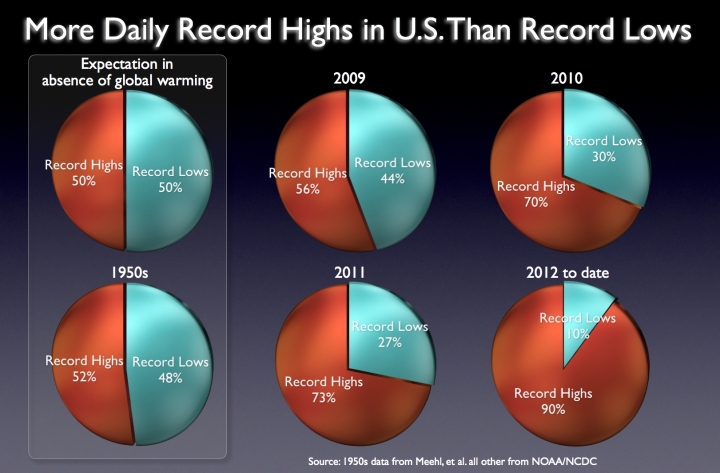The following is not a top ten list. It’s just what I could quickly pen as a way of introducing a subject that has been reported frequently about our July this year here in North America – the hottest on record in the Continental United Sates since records were kept. And by the way, it has been pretty hot up here in Canada as well. We’ll start with the list and then get to the real issue at hand.
1. Lots of animals that live in the cold no longer will have a place to live. Say goodbye to reindeer, polar bear and musk ox. And while your at it, say goodbye to brook and lake trout and other freshwater game fish as rivers and lakes heat up. And if you like to ski, start figuring out where there will still be snow for your winter and spring vacations.
2. If you like maple syrup you’ll have to get it from Quebec if it gets cold enough north of the border because maple trees in Vermont, New Hampshire, Upstate New York and Maine will never experience a freeze and the sap will never start running.
3. Florida vacations will come to an end as those famous wide beaches disappear replaced by ever higher sea walls. Island beach vacations will disappear as well as islands become inundated.
4. Waterfront real estate will become underwater real estate or if you are lucky that ocean view will now be a concrete wall and a hope and a prayer that no storm surge will breach it.
4. If you like your morning Arabica switch to tea because warming will destroy the coffee growing areas where the beans are picked.
5. You will no longer watch outdoor professional sports on summer days or evenings because hyperthermia will be a likely outcome not just for the athletes but also for those sitting in the stands.
6. Forget about your favorite wine. Find a new one because more than likely your old favorite will come from an area where wine grapes will no longer grow.
7. Look out for a whole bunch of new insect-borne diseases as breeding areas expand – Lyme, Dengue fever, malaria, Chagas….you name it. And allergy sufferers, don’t bother trying to escape to cottage country. The plants and pollens are moving north.
8. Forget shelling, snorkeling and scuba diving as coral reefs die and shell fish lose their shells to an ocean that is increasingly acidic because of dissolved CO2.
9. Switch to a chocolate substitute as cocoa crops fail in Ivory Coast and other growing areas.
10. Find a new foreign beer to drink as barley and hops harvests fail in Germany.
I could go on but won’t for now. Just trying to get you to sit up and start noticing what’s going on around you even though politicians continue not to act. And they do this based on what they describe as a paucity of facts, that global warming isn’t proven, just a theory.
We know that weather is not climate change. Nor is weather global warming. But a prolonged heat wave and drought should make you sit up and take notice. And when a whole bunch of scientists, including former climate change deniers, start talking about the facts of global warming, it shouldn’t take a dramatic leap in logic to put in place policies and processes that begin to mitigate the problem.
So is what we are experiencing in North America this summer atmospheric warming or an aberration? Is this human induced climate change? It certainly is hot. On that we all agree. And the headlines even at Fox Media are shouting – “July – the hottest month in the lower 48 states on record.”
And here are the barebones statistics to back those headlines.
- Average temperature for July 2012 = 25.33 Celsius (77.6 Fahrenheit)
- That’s 1.83 Celsius (3.3 Fahrenheit) higher than the 20th century average temperature.
- That’s 0.11 Celsius (0.2 Fahrenheit) hotter than July 1936, the previous hottest month on record.
- The last 12 months ending with July represent the warmest 12 consecutive months since record keeping began in 1895.
- In 2011 the United States experienced 26,674 record-breaking high temperatures that equaled or exceeded the previous high.
- So far in 2012 as of August 5, that number is 27,042. And we still have more than four months to go.
- The ratio of daily record high temperatures to daily lows jumped from 3:1 in 2011 to 10:1 so far in 2012.
- Record daytime temperatures have been followed by warmer than average nighttime temperatures contributing to higher evaporation rates and drier conditions. In fact, drier than the Dust Bowl extreme weather conditions of the 1930s.
Weather scientists agree that warmer overnight temperatures are of greater concern than record high daytime temperatures. Cool nights allow humans, animals and plants to recover from daytime heat. Warm overnights may be the best indicator yet of overall planetary warming.

That was July and now we are in August – still hot and dry. But summer will come to an end won’t it?








